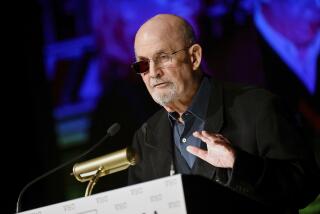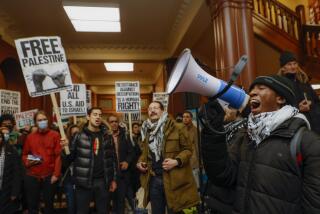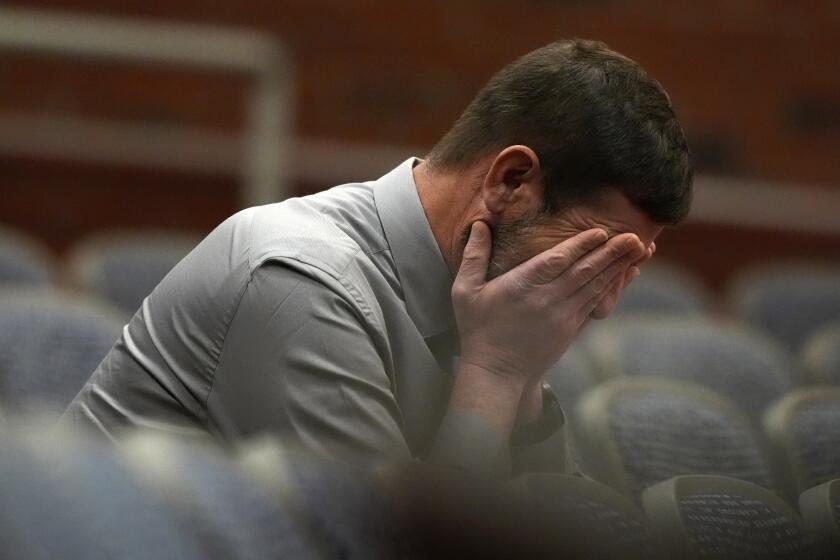French satire magazine’s raison d’etre: mocking, challenging
The prophet is locked in an embrace, his arm encircling a French cartoonist, their lips locked. They drool.
The prophet raises a finger, pointing to a word bubble. “100 lashes if you don’t laugh.”
The prophet is on all fours, genitals exposed, a five-pointed star between his legs. “A star is born!”
These were among the images that brought international attention, scorn, praise and death threats to Charlie Hebdo, the French satirical magazine that takes profane aim at the shibboleths of politics, culture and religion, particularly conservative ones.
Editor Stephane Charbonnier knew the risks of publishing such images, particularly those depicting the prophet Muhammad. Several Muslim hadiths — reports about the teachings of the faith — forbid such visual representations. Charbonnier believed the threats came from a small minority that was unlikely to act.
“It just so happens I’m more likely to get run over by a bicycle in Paris than get assassinated,” he told the Los Angeles Times in 2013.
But he wasn’t unaware of the risks. Asked whether he was worried about being targeted, he replied, “Yeah, that’s rather bothersome.” He said it would be harder to do the job, which he took in 2009, if he had a family to worry about.
Absent a family, gunmen apparently targeted the closest thing.
On Wednesday, in an attack foreshadowed by a 2011 firebombing, 12 people were shot and killed in an attack on the magazine’s Paris offices. Armed with pump-action shotguns and a Kalashnikov assault rifle, gunmen killed 10 members of the magazine staff, including Charbonnier, and two police officers. Five more people were reportedly seriously injured.
Charbonnier, known as Charb, took over the magazine in 2009. A soft-spoken, bespectacled Parisian in his 40s, he was dedicated to the idea that the magazine could do what polite commentary could not: force society to confront its taboos, consequences be damned.
It was a tradition.
Charlie Hebdo began in 1969 as Hara-Kiri, a reference to the Japanese form of ritual suicide. From the start, it invited controversy. A cover after the death of French President Charles de Gaulle came just a week after a massive fire killed more than 140 people in a nightclub; the magazine mocked news coverage of the events with a headline that read, in part: “One dead.”
Hara-Kiri was banned, but it didn’t go away. Maintaining the same group of people, the publication became Charlie Hebdo. “Charlie” was a not-so-subtle reference to the De Gaulle controversy, as well as a nod to the Peanuts character Charlie Brown. “Hebdo” was a diminutive of hebdomadaire, or weekly. It closed in 1981, but a group of disaffected cartoonists and a stand-up comic revived it in 1992.
Philippe Val led the publication during a time when Muslim emigration from North Africa to France combined with growing numbers of second- or third-generation Muslim French youth to form a significant bloc. He made Islam a target.
Val opposed head scarves and fought with fellow leftists. He was hauled into court in 2007 by a lawsuit brought by Muslim groups, but the court found that he did not defame Muslims and cleared him. Then, he was gone, appointed to a public radio station by conservative President Nicolas Sarkozy.
Enter Charb. He sought to move away from the rhetoric and back toward irreverence. Muhammad remained a topic, perhaps in part because the reaction was often so virulent. By 2012, Charbonnier said he was publishing the images simply to justify their publication — a stance that delegated the art itself to a back seat. The act of publication took center stage.
Muslims in ardently secular France, many largely marginalized in the Parisian exurbs and facing discrimination over their dress and skin color, considered the magazine’s content a form of hate speech. The Collective Against Islamophobia in France has insisted that the magazine does more harm than good.
“Socially speaking, France is in a bad state,” spokeswoman Sumeja Rahmani said in a 2013 interview with The Times. “What are these cartoons worth other than ridiculing Muslims more and devaluing them, insulting and offending them?”
It wasn’t only French Muslims who thought the crude drawings to be in poor taste, as well as needlessly inflammatory. Nor was Islam the only target — far from it. Presidents, those opposed to same-sex marriage, the pope, the American GOP, military action in the Middle East, privatization, deregulation — all of it took the clubbing of a Charlie Hebdo candy-color front.
French politicians questioned the balance of editorial freedom and potential harm, some saying the cartoons were weighted heavily toward the latter. They were united in condemnation of the attacks Wednesday.
Charlie Hebdo’s website went offline Wednesday, and then displayed the words “Je suis Charlie” — “I am Charlie” — against a black background. The phrase was widely used by the magazine’s supporters internationally and became a popular Twitter hashtag.
Other French news outlets offered their facilities for the magazine to resume publication.
U.S. Secretary of State John F. Kerry rejected the notion that the attacks reflected a conflict between civilizations. “It is between civilization itself and those opposed to the civilized world,” Kerry said.
Steve Benson, the Pulitzer Prize-winning cartoonist for the Arizona Republic, said there was never an excuse for violence against speech, even if some found it irresponsible.
“Who is to determine what is responsible and what is not responsible? A bunch of camouflaged thugs who break into journalism offices and say ‘God is great and you are dead?’” he said. “I don’t believe that anyone has the right to kill someone else over what someone else believes.”
That’s a common belief in free societies, even if some have made blasphemy a crime.
Benson argued that magazines such as Charlie Hebdo are at the front lines of a vital conflict.
“Art is not done to decorate apartments, but to wage war against the enemy,” Benson said, paraphrasing Picasso. “In the front lines of free speech, art is a trench soldier. Always has been, always will be.”
Charlie Hebdo was glad to take up arms in 2006, delighting in reprinting 12 Danish cartoons, most of which depicted caricatures of the prophet Muhammad. Those cartoons incited protests and violence throughout the Muslim world after their publication in 2005 by the Danish newspaper Jyllands-Posten.
But provocation was not the aim. Well, not the only aim.
“Charlie is trying to analyze the controversy and its consequences,” an editorial explained after the weekly published the Danish cartoons. “It’s a question of showing that the freedom of expression should be stronger than intimidation.”
The New Yorker’s cartoon editor in 2012, Robert Mankoff, offered up what he said was the only inoffensive cartoon possible. “Please enjoy this culturally, ethnically, religiously and politically correct cartoon responsibly.”
It was four black lines. An empty box.
Twitter: @nigelduara
More to Read
Start your day right
Sign up for Essential California for news, features and recommendations from the L.A. Times and beyond in your inbox six days a week.
You may occasionally receive promotional content from the Los Angeles Times.







